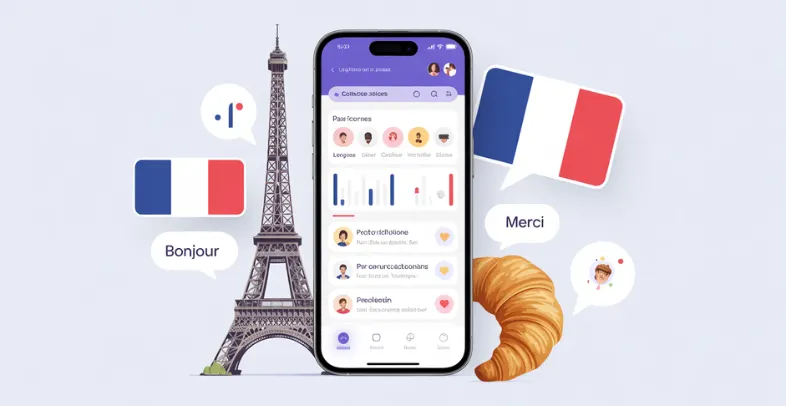In today’s competitive job market, employee recognition is no longer just a nice gesture from HR. It has become a vital part of business strategy. More organizations are using digital tools to make sure that recognition is timely, visible, and fits with their workplace culture. Research backs this change. According to Gallup’s State of the Global Workplace, employees who feel genuinely appreciated are 56% less likely to consider leaving their jobs and show 23% higher productivity than those who do not feel appreciated. The shift to remote and hybrid work has made traditional ways of showing appreciation, like in-person celebrations or casual praise, less effective since teams often work in different locations and time zones.
Employee Recognition Software helps close this gap by providing a centralized way for managers and coworkers to acknowledge achievements, track engagement, and connect rewards to clear performance indicators. The demand for these platforms is growing quickly. Grand View Research predicts the market will reach $6.4 billion by 2030, with a growth rate of 8.5%. This increase is driven by new tools such as AI-powered analytics, instant feedback channels, and global reward options.
For HR leaders, the challenge is to select a solution that meets business goals while addressing the different needs of employees. This means understanding platform features, how easily they integrate, and the measurable return on investment of recognition efforts. In this guide, we will look at the broader role of employee recognition software, its benefits, common types, best practices for successful use, and new trends before examining the top platforms available today.
What is Employee Recognition Software
Employee Recognition Software is a digital system that is designed to celebrate employee achievements both formally and informally. Unlike annual performance reviews, these platforms allow for ongoing recognition through peer shoutouts, manager awards, milestone tracking, and points-based reward systems.
The main goal is to make recognition a regular, clear, and trackable part of daily work life. Common features include:
- Social-style recognition feeds that function like internal networks
- Automated celebrations for birthdays, work anniversaries, and achievements
- Integration with HR systems to sync employee profiles and important dates
- Reward catalogs that offer vouchers, experiences, or branded merchandise
- Analytics dashboards to measure engagement levels and pinpoint gaps in recognition
By combining these features, recognition software promotes a workplace culture where appreciation is part of daily operations instead of just an occasional HR activity.
Why Employee Recognition is Essential
Recognition does more than boost morale; it also impacts business performance. According to a 2023 SHRM study, 68% of HR professionals saw better retention rates after implementing structured recognition systems. Employees who feel valued tend to be more engaged, committed, and likely to promote their organization’s goals.
Some key benefits include:
- Reduced Employee Turnover: A solid recognition program fosters a sense of belonging and purpose. Research from Workhuman shows turnover can decrease by as much as 31% when organizations invest in consistent recognition efforts.
- Increased Productivity: Employees who feel recognized are more driven to produce high-quality work. Harvard Business Review indicates that recognition can boost individual productivity by 12% or more.
- Improved Company Culture : When recognition aligns with company values, it reinforces positive behaviors and strengthens a common identity.
- Better Customer Experience : Engaged and satisfied employees are more likely to provide excellent customer service, leading to improved client satisfaction and loyalty.
Types of Employee Recognition Software
Recognition platforms come in many forms. However, most fit into a few main categories based on their key functions:
Peer-to-Peer Recognition Platforms
These systems let employees recognize each other directly. They often use digital badges, appreciation messages, or points that can be exchanged for rewards later. By allowing recognition at all levels, they help reduce barriers between teams and promote collaboration.
Manager-Led Recognition Tools
In this model, most recognition comes from supervisors, team leads, or HR. These tools are often used for merit-based awards, compliance acknowledgments, and formal praise based on performance metrics.
Reward-Integrated Solutions
These platforms combine recognition features with rewards like e-gift cards, merchandise, or special experiences. They usually partner with global vendors to serve teams spread across different locations.
Social Recognition Systems
Modeled after social media, these tools include company-wide feeds where every recognition post is visible to all employees. The public nature of the feed boosts transparency and enhances the motivational effect of each acknowledgment.
Milestone & Service Award Programs
These solutions celebrate tenure, project completions, and other important career moments. They use automation to ensure key events are never overlooked.
Key Features to Consider in Recognition Software
- When looking at potential platforms, organizations should match the tool’s features with their business goals and employee needs. Important features include:
- Customizable Recognition Frameworks: Flexibility to define types of recognition, criteria, and branding that reflect company values.
- Multi-Platform Accessibility: Seamless use across web and mobile, along with integrations with tools like Slack, Microsoft Teams, or Google Workspace.
- Global Reward Options: Vendor partnerships that offer localized rewards for international teams.
- Data & Analytics: Detailed insights into recognition trends, engagement rates, and return on investment.
- Gamification Elements: Points, challenges, and leaderboards to encourage friendly competition.
- Automated Triggers: Scheduled recognitions for birthdays, work anniversaries, or project milestones without needing manual input.
Best Practices for Implementation
A successful rollout involves more than just installing new software; it also requires cultural acceptance. Insights from companies like Cisco and Atlassian show that effective programs follow these principles:
- Set Clear, Measurable Goals: Clearly define what you wish to achieve, whether it’s improving employee retention, increasing morale, or reinforcing company values, before selecting a platform.
- Gain Leadership Support: When senior leaders take part in recognizing employees, it sends a strong message about the value of appreciation.
- Test Before Full Launch: Begin with a pilot phase to fix technical issues, refine processes, and gather feedback from early users.
- Encourage Widespread Engagement: Internally promote the platform through gamification, recognition campaigns, and consistent communication to boost participation.
- Track Results & Improve: Use analytics to evaluate program performance, find recognition gaps, and make ongoing improvements over time.
List of Employee Recognition Software
1. Bonusly
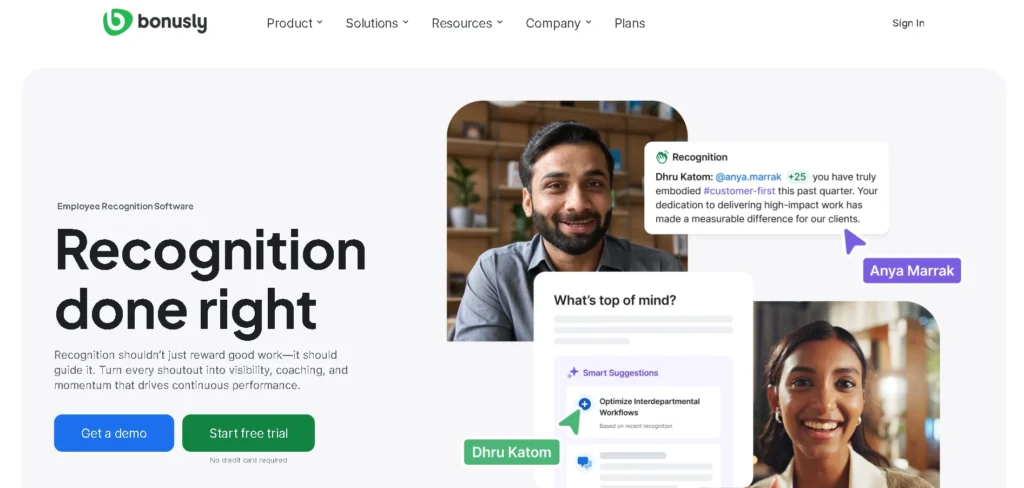
Bonusly has become a popular choice among organizations for its simple and effective approach to employee recognition. It offers real-time peer-to-peer acknowledgments that fit easily into daily work. This platform is suitable for both remote and on-site teams. It allows staff to send small but meaningful “micro-bonuses” that appear instantly in a company-wide social feed. Employees can redeem these bonuses for gift cards, charitable donations, or custom company perks, fostering a culture of appreciation.
Bonusly integrates easily with tools like Slack, Microsoft Teams, and email, enabling employees to participate without switching platforms. Its analytics dashboard gives HR leaders important insights into recognition activity, employee engagement, and how well company values reflect in daily actions. With its user-friendly design, visibility, and measurable results, Bonusly is effective for businesses of all sizes that want to make recognition a regular part of work life.
Features:
- Real-time micro-bonus system tied to a diverse rewards catalog
- Company-wide social feed for transparent recognition
- Smooth integrations with Slack, Microsoft Teams, HRIS, and email
- Analytics to track participation, engagement, and value alignment
- Global redemption options, including charitable giving and gift cards
Pricing:
- Appreciate: $2 per user/month (billed annually)
- Connect: $5 per user/month (billed annually)
- Achieve: $7 per user/month (billed annually)
- Custom enterprise pricing is also available.
2. Kazoo (Worktango)
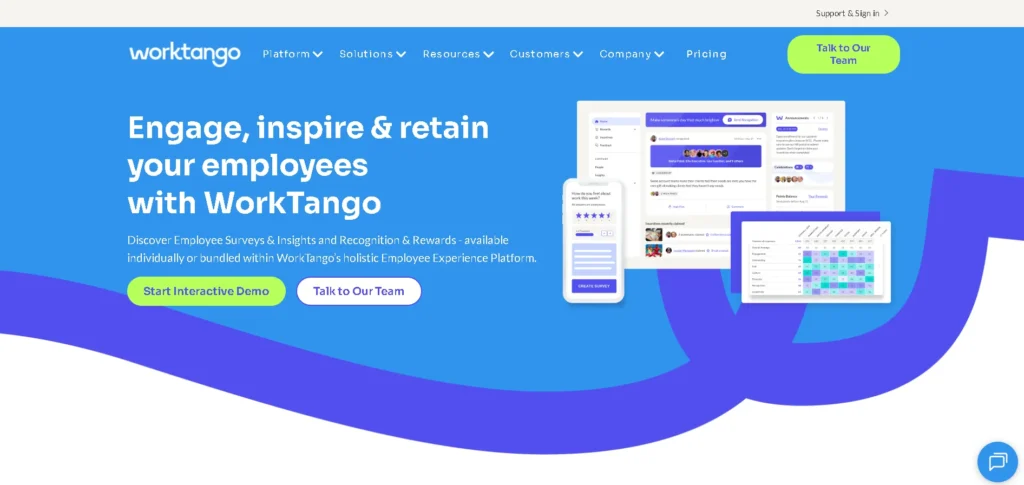
Kazoo offers a unified employee experience platform that combines recognition, performance management, and engagement tools in one place. It allows both peers and managers to give points-based rewards. Employees can redeem these rewards for personalized incentives, directly linking appreciation to business results. In addition to recognition, Kazoo includes ongoing feedback loops, goal-setting tools, and engagement surveys.
As a comprehensive HR Management Software solution, Kazoo provides organizations with a complete view of workforce performance and morale. Its user-friendly interface promotes high adoption rates, and integrations with HRIS and collaboration tools ensure smooth workflows. Robust analytics help HR teams measure how recognition affects retention, productivity, and cultural alignment. Kazoo’s adaptable rewards marketplace meets diverse employee preferences, making it suitable for mid-sized and large organizations that want to connect recognition to strategic goals.
Features:
- Peer and manager recognition with a points-and-rewards model
- Tools for goal-setting and ongoing performance management
- Fully customizable rewards marketplace
- Engagement surveys and employee feedback tools
- Connectivity to enterprise communication platforms and HRIS
Pricing:
- pricing that is tailored to the demands and size of the business.
3. Achievers
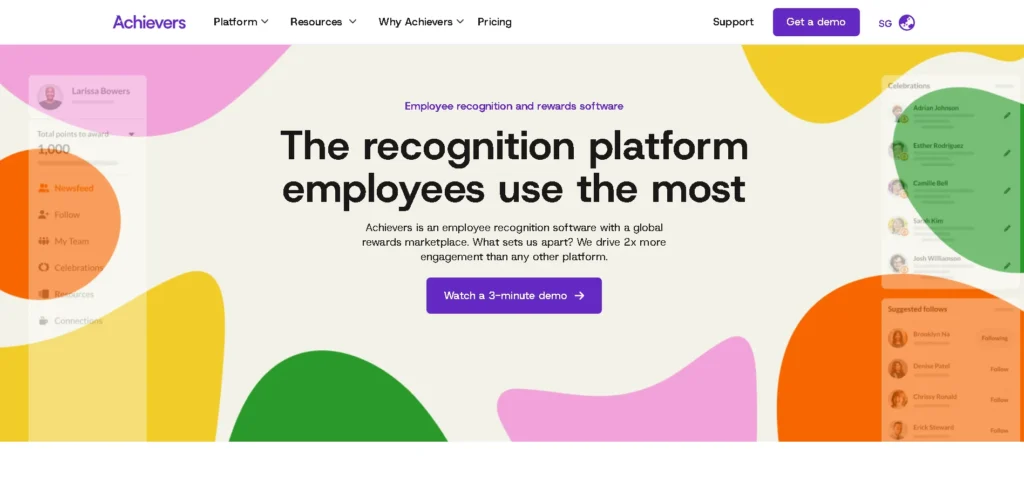
Achievers is a scalable platform designed to increase engagement and strengthen culture through social recognition and rewards. Employees, managers, and executives can share public “Cheers” or badges to acknowledge accomplishments, fostering a sense of appreciation and motivation. The platform includes a customizable rewards catalog featuring merchandise, gift cards, and unique experiences.
It also automates milestone and anniversary celebrations to honor career achievements. Pulse surveys and advanced analytics help HR leaders track engagement trends, identify challenges, and take steps to improve retention. Achievers integrates easily with enterprise systems, making it ideal for medium to large organizations looking for a recognition program that grows with them.
Features:
- Public “Cheers” for recognition across all levels
- Diverse, customizable rewards catalog
- Automated milestone and anniversary celebrations
- Pulse surveys for real-time engagement feedback
- Detailed analytics and reporting capabilities
Pricing:
- Custom pricing; demo available.
4. Terryberry

Terryberry focuses on creating tailored employee recognition programs that highlight service awards, peer recognition, and timely feedback. Organizations can design programs that showcase their culture and goals while the platform tracks and celebrates key milestones, such as work anniversaries and significant achievements.
Terryberry offers both physical and digital rewards, providing a flexible catalog to meet various employee preferences. Managers receive real-time alerts to ensure all contributions are acknowledged, and the company’s consultative approach helps clients develop effective recognition strategies. With strong customer support, Terryberry appeals to organizations seeking a personalized and culture-focused recognition solution.
Features:
- Peer recognition and manager-led award capabilities
- Tracking for service anniversaries and key achievements
- Customizable physical and digital reward catalogs
- Real-time alerts for timely acknowledgments
- Program design and strategic consultation services
Pricing:
- 360 Recognition Platform: Starts under $250 per month for up to 99 participants, plus a one-time setup charge.
- Give a WOW QuickStart: Starts at $99 per month with no setup fee.
- Service Awards: The cost for service awards is often a separate program with a different pricing model, estimated at around $25–$35 per year of service
Suggested Read : Best MDM Software Solutions
5. Workhuman
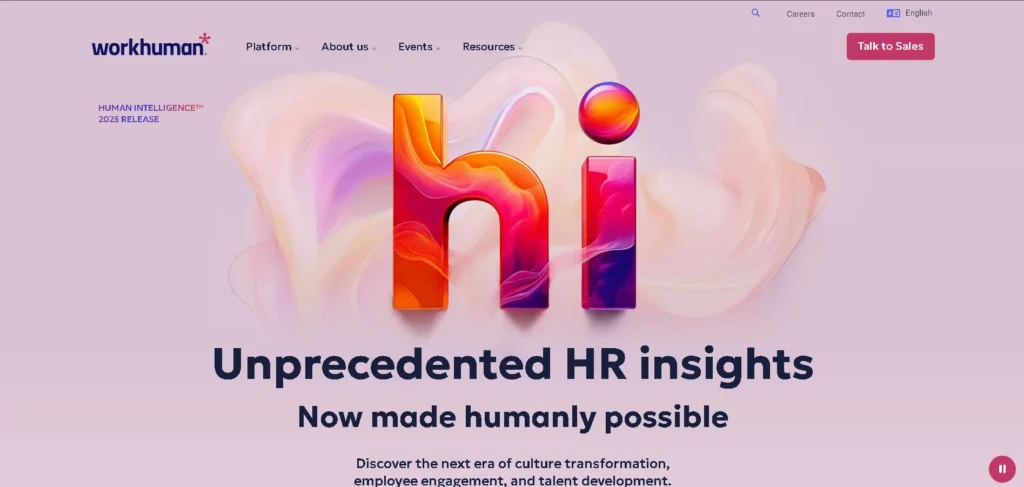
Workhuman is a global recognition platform that aims to embed appreciation into daily work while supporting long-term employee engagement. It facilitates real-time peer and manager recognition, which is visible company-wide. This reinforces actions that align with organizational values. The platform also automates milestone and service award celebrations, making it easy to recognize daily contributions and significant achievements.
Deep integrations with HRIS and payroll systems ensure smooth adoption across large organizations. A key feature is its data-driven insight tools, which offer visibility into engagement trends, potential retention risks, and diversity metrics. This empowers HR teams to take targeted action. With its scalability and comprehensive features, Workhuman is well-suited for large, globally distributed companies.
Features:
- Real-time, company-wide recognition from peers and managers
- Automated service award and milestone celebrations
- Recognition linked to organizational values and goals
- Advanced analytics for engagement and retention insights
- Integrations with HRIS and payroll systems
Pricing:
- Custom enterprise pricing.
6. Motivosity
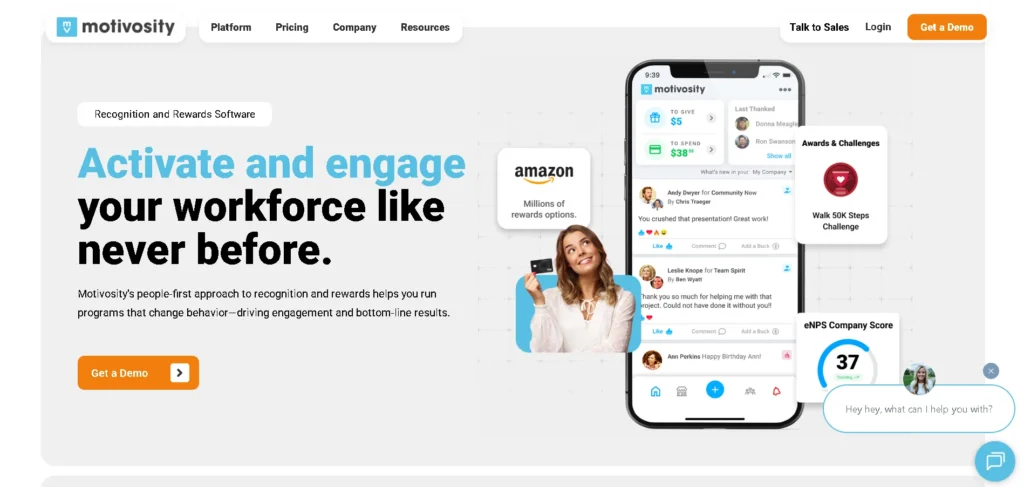
Motivosity aims to create a culture of gratitude through an intuitive peer-to-peer recognition system. Employees can send “thank you” points to colleagues for their contributions, which they can exchange for rewards or receive as public acknowledgment in the platform’s social feed. Managers can highlight team achievements in real time to ensure that recognition is timely and visible.
The platform integrates smoothly with Slack and Microsoft Teams, bringing recognition into daily communication channels. Additional features like pulse surveys and engagement analytics give HR leaders insight into employee morale and cultural health. With its simple design and practical tools, Motivosity is ideal for organizations wanting to boost engagement without changing existing workflows.
Features:
- Peer-to-peer recognition with a points-based system
- Manager-led shout-outs for individual and team achievements
- Integrations with Slack and Microsoft Teams
- Pulse surveys to monitor morale
- Analytics dashboard for tracking trends and program impact
Pricing:
- Connect at $1, Listen at $2
- Recognize at $3
- Lead at $6.50.
7. Reward Gateway
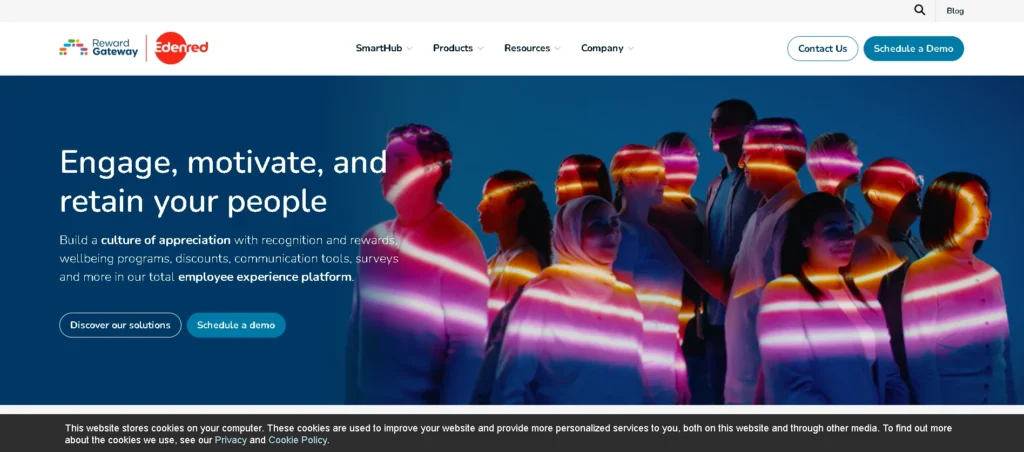
Reward Gateway provides an employee experience platform that combines recognition tools with communication, benefits, and engagement solutions. Its recognition module supports both peer-to-peer and manager-driven appreciation through badges, points, and customizable rewards. A company-wide social feed showcases achievements, creating transparency and promoting a culture of acknowledgment.
In addition to recognition, Reward Gateway offers employee discount programs, perks, and wellness initiatives, making it a complete solution for enhancing satisfaction and retention. With solid integrations into HRIS and collaboration systems, it can be easily implemented in large and diverse organizations.
Features:
- Peer and manager recognition via badges, points, and rewards
- Public social feed to share and celebrate accomplishments
- Customizable rewards catalog
- Employee benefits, discounts, and wellness programs
- Integrations with HRIS and workplace collaboration tools
Pricing:
- Custom pricing based on organization size and needs.
8. Blueboard
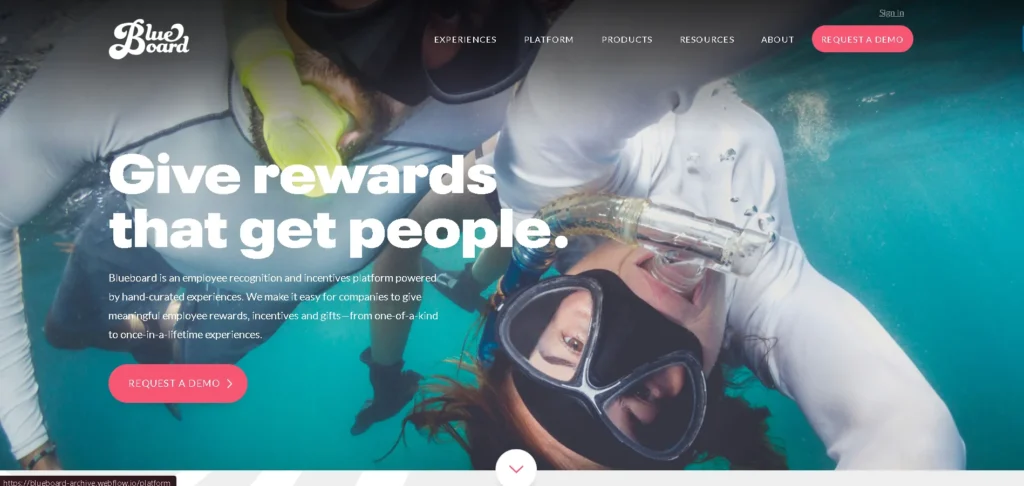
Blueboard sets itself apart by offering experiential rewards instead of traditional merchandise or gift cards. Employees can exchange earned points for unique experiences, such as travel adventures, cooking workshops, or wellness retreats, creating lasting personal memories linked to recognition.
Managers have access to easy-to-use tools for sending recognitions quickly, while analytics features track engagement and program effectiveness. This focus on experiences appeals to companies looking to provide meaningful, non-traditional incentives that resonate personally and strengthen employee loyalty.
Features:
- Curated experiential rewards, from travel to wellness activities
- Personalized options tailored to individual preferences
- Manager-friendly recognition tools
- Analytics and reporting to track program success
- Integrations with HR and engagement platforms
Pricing:
- Custom pricing based on company needs and program scope.
9. Kudos
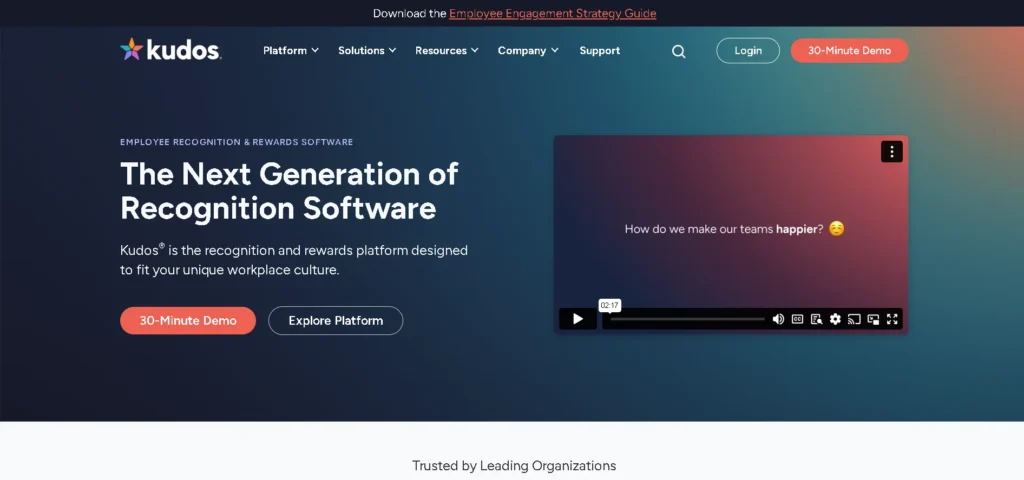
Kudos is a recognition-focused platform designed to promote positivity and inclusivity through social, peer-to-peer appreciation. Employees can send personalized messages and badges that appear in a public company feed, fostering transparency and community.
The platform also has a rewards marketplace with various redemption options, and manager dashboards allow for tracking participation, engagement, and overall program health. Its emphasis on social interaction and simplicity makes Kudos effective for organizations wanting to humanize recognition while boosting morale.
Features:
- Peer recognition with customizable badges and messages
- Company-wide social feed for public acknowledgments
- Rewards marketplace with various incentives
- Manager dashboards to monitor engagement
- Integration with widely used technologies for workplace collaboration
Pricing:
- Custom Pricing
10. Snappy
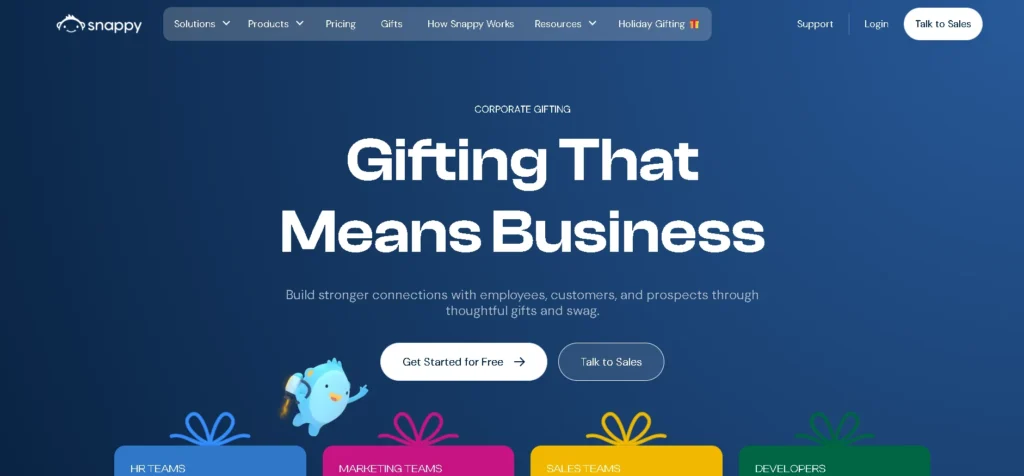
Snappy reimagines recognition by focusing on immediacy and personalization. It allows managers and peers to send digital gift boxes that contain curated items like snacks, wellness products, or branded company merchandise. These gifts are delivered directly to employees’ homes or offices, making recognition tangible and memorable.
The platform’s streamlined workflows reduce administrative tasks, while its customization options let organizations tailor gifts to their culture. Built-in analytics help measure the reach and effectiveness of gifting campaigns, making Snappy especially attractive for remote or geographically dispersed teams looking for a personal touch in their recognition efforts.
Features:
- Digital gift boxes with curated, tangible rewards
- Peer and manager recognition capabilities
- Customizable gifting themes and options
- Analytics to measure recognition campaign performance
- User-friendly design suited for remote and distributed teams
Pricing:
- Essential: $0 per year (you only pay for gifts claimed).
- Elevated: $999 annually.
- Enterprise: Custom quote.
11. O.C. Tanner
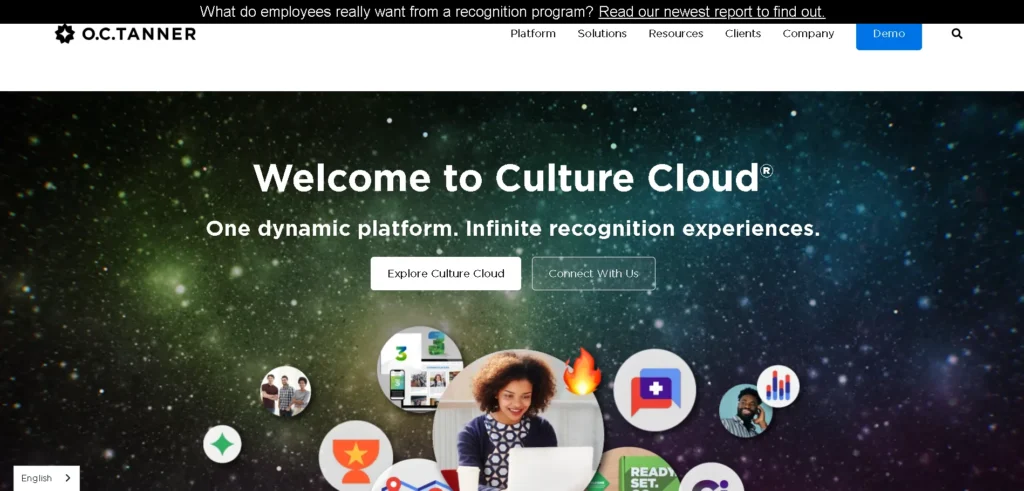
O.C. Tanner is a popular employee recognition platform that aims to create strong workplace cultures by using recognition and reward programs. It encourages social recognition, so employees and managers can acknowledge achievements publicly.Anniversaries and service awards are among the milestones that are celebrated on the site. O.C.
Anniversaries and service awards are among the milestones that are celebrated on the site. O.C. Tanner offers a customizable experience, helping organizations connect recognition to company values and goals. It works well with major HRIS and payroll systems and provides analytics to track engagement and retention. With features suited for large businesses, it excels at fostering long-term employee loyalty.
Features:
- Social and manager recognition with public visibility
- Milestone and service anniversary awards
- Personalized recognition initiatives based on business principles
- Integration with HRIS, payroll, and other enterprise systems
- Detailed analytics for tracking engagement and retention
Pricing:
- Custom pricing based on enterprise needs
12. Assembly
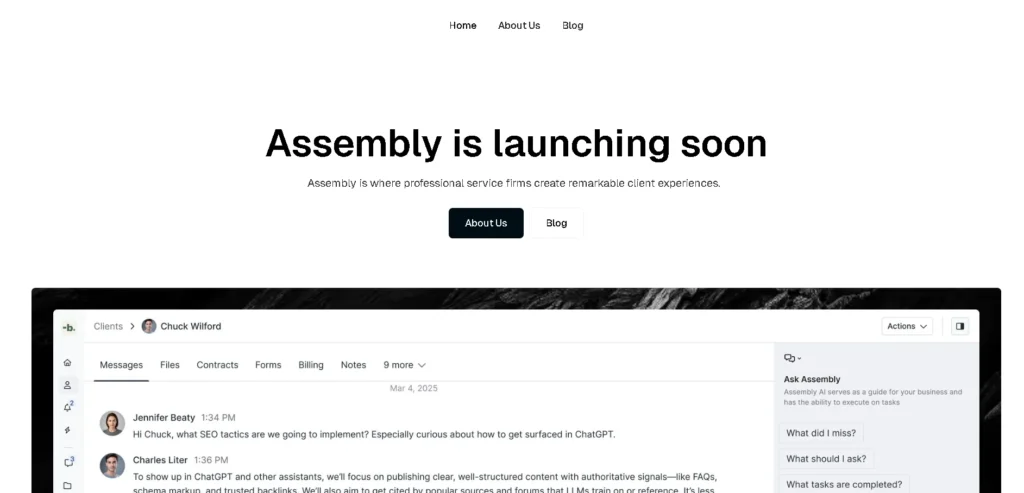
Assembly is a straightforward employee recognition platform that makes peer-to-peer recognition quick and engaging. Employees can send points as tokens of appreciation, which appear in a social feed. This encourages a culture of ongoing recognition. The points can be exchanged for various rewards, promoting active participation.
Assembly integrates with tools like Slack and Microsoft Teams, making recognition a natural part of daily work. Managers can access analytics to monitor participation rates and engagement levels. Assembly’s simple design and focus on integration make it a solid choice for growing companies wanting to boost morale and team spirit.
Features:
- Points-based peer recognition with a public social feed
- Redeemable rewards catalog
- Integrations with Slack and Microsoft Teams
- Manager dashboards with analytics
- Easy onboarding and adoption
Pricing:
- Celebrate: $2 per user/month (billed annually)
- Empower: $4 per user/month (billed annually)
- They also offer a custom plan for larger organizations.
13. Reflektive
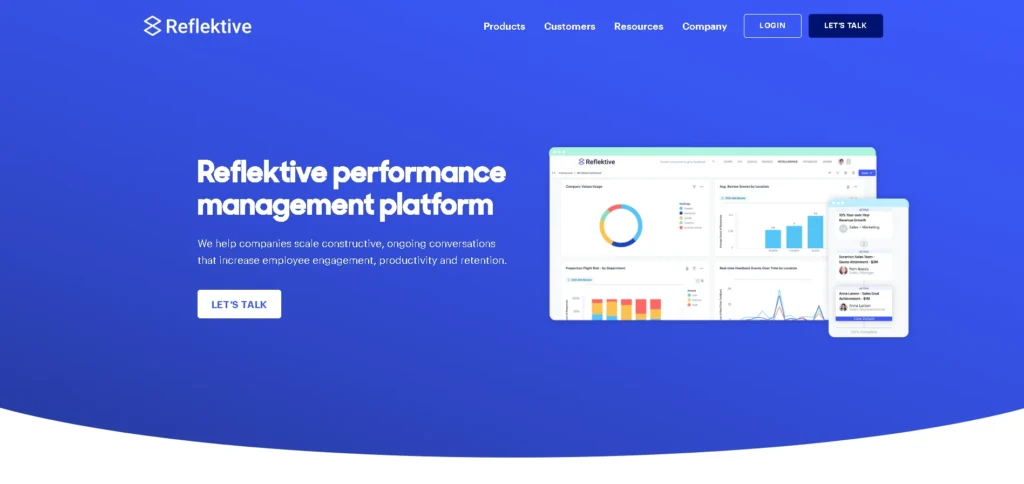
Reflektive offers a modern employee recognition solution that also includes continuous performance management features. It lets employees and managers give real-time praise, fostering a positive feedback culture that supports development and engagement. Reflektive’s platform includes tools for goal tracking, regular check-ins, and performance reviews, linking recognition to growth and productivity.
The system provides insights through strong analytics, helping HR teams understand employee sentiment and performance trends. With integration into major HRIS platforms, Reflektive fits seamlessly into existing workflows. It is ideal for organizations that want to combine recognition with performance management in one tool.
Features:
- Real-time peer and manager recognition
- Ongoing feedback and performance reviews
- Goal setting and tracking
- Analytics on engagement and performance
- Integration with HRIS and communication tools
Pricing:
- Custom
14. Guusto
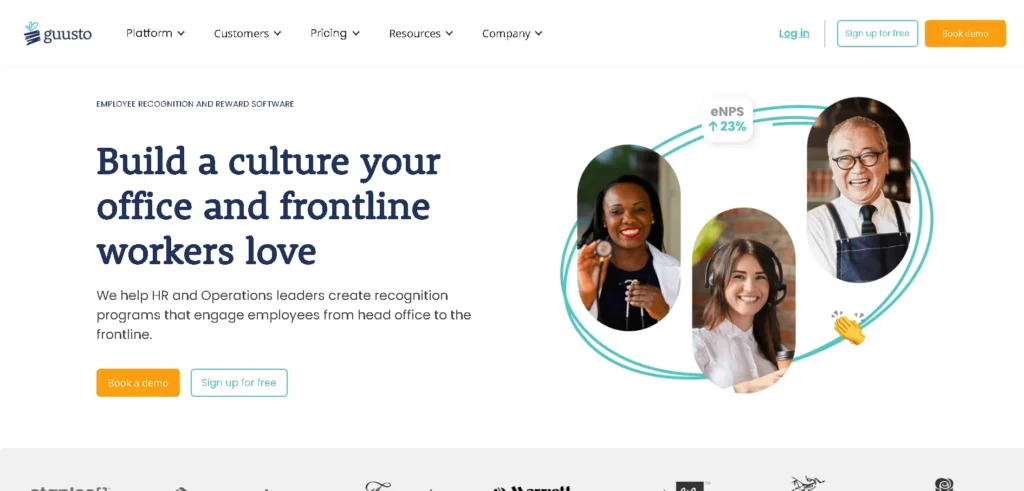
Guusto simplifies employee recognition by allowing managers and peers to send instant digital gift cards as rewards. It supports both peer-to-peer and manager-led recognition, promoting a culture of appreciation with minimal hassle. Guusto offers various gift card options to suit different employee preferences.
Analytics dashboards are included in the platform to monitor redemption rates and the general efficacy of the scheme. Guusto is user-friendly and focuses on tangible rewards, making it ideal for distributed teams and companies seeking quick results through recognition.
Features:
- Instant digital gift card delivery for recognition
- Options for peer and manager recognition
- Wide variety of gift card selections
- Analytics and reporting dashboards
- Easy-to-use interface for quick adoption
Pricing:
- Individual: Free
- Essential: $2.25 per user/month
- Premium: $3.50 per user/month
15. Recognize
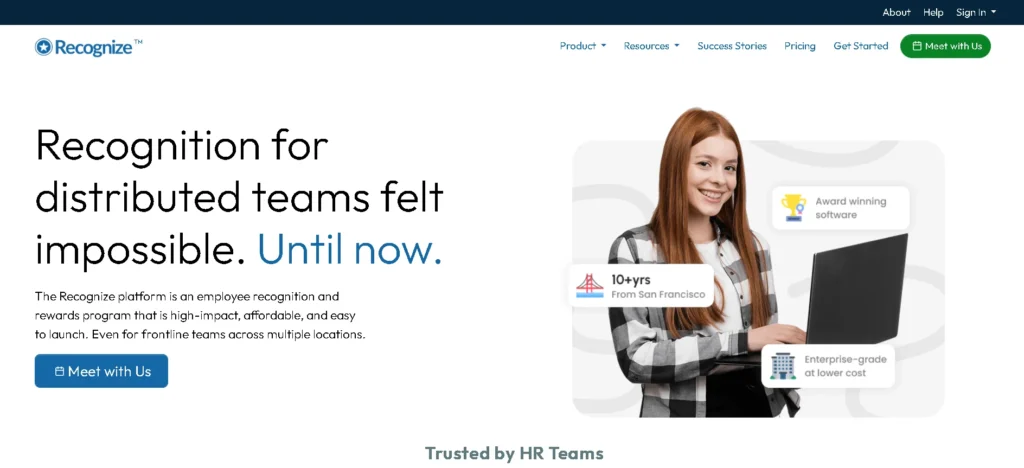
Recognize is a complete employee recognition and rewards platform focused on building a social culture of appreciation. It provides peer-to-peer recognition tools, manager-led awards, and the ability to celebrate milestones like birthdays and work anniversaries. Recognize features a social activity feed where all recognitions are visible, encouraging transparency and collective morale.
The platform supports rewards points that can be redeemed for various incentives and integrates with collaboration tools like Slack and Microsoft Teams. Recognize also gives managers and HR leaders insights through analytics to track engagement and improve recognition strategies.
Features:
- Peer and manager recognition with a social feed
- Milestone celebrations and customizable awards
- Points-based rewards system with a range of redemption options
- Integrations with Slack, Microsoft Teams, and other tools
- Analytics dashboard for program insights
Pricing:
- Personalized prices based on user base and features
Challenges and Pitfalls to Avoid
While recognition software can provide significant cultural and performance benefits, its effectiveness can decrease if not implemented with care. Common pitfalls include:
- Low Participation. If employees find the platform complicated or are unaware of it, engagement can remain low.
- Recognition Fatigue. Too much or insincere praise can make recognition feel forced instead of meaningful.
- Uncontrolled Costs. Without proper management, reward budgets can quickly go beyond expectations.
- Cultural Disconnect. Recognition criteria that do not match employee values or local customs can cause problems.
Addressing these risks through careful design, clear guidelines, and ongoing communication helps ensure lasting use and returns on investment.
Measuring the ROI of Employee Recognition Programs
Demonstrating the value of recognition software is important for maintaining investment and improving program design. While its effect on morale and culture is significant, there are specific metrics organizations can track:
- Reduced Employee Turnover. Replacing employees is expensive—often 1.5 to 2 times an employee’s annual salary. Recognition programs that encourage loyalty and engagement can reduce voluntary turnover, with before-and-after comparisons providing clear financial evidence.
- Higher Engagement Scores. Regular employee surveys can show changes in engagement levels. A post-implementation increase often suggests stronger commitment, which is closely related to retention and productivity.
- Improved Productivity. Recognition promotes positive behaviors that boost performance. Research from Harvard Business Review shows that recognized employees produce about 12% more on average. Linking recognition activities to department outcomes can reveal useful trends.
- Participation Rates. Successful programs see recognition happening across all levels and departments—not just from managers. Tracking the number of employees giving and receiving recognition can indicate cultural reach.
- Customer and Revenue Gains. Motivated employees tend to provide better customer experiences, leading to higher Net Promoter Scores (NPS) and revenue growth.
Integration Strategies for Smooth Adoption
Recognition tools work best when they are integrated into the existing tech environment seamlessly. Successful integration typically includes:
- Collaboration Platform Connections: Embedding recognition in Slack, Microsoft Teams, or Google Workspace keeps it visible and easy to use.
- HRIS Integration: Syncing employee data allows for automated milestone recognition and accurate reporting.
- Linking to Performance Management: Connecting recognition with formal reviews creates a complete record of contributions.
- Mobile Access: Mobile apps make on-the-go recognition possible for remote, hybrid, and frontline staff.
- Single Sign-On (SSO): This simplifies logins and lowers barriers to participation.
Companies that focus on integration often see adoption rates rise by 30% or more, leading to better program results.
Future Trends in Employee Recognition Technology
Recognition technology is changing quickly, influenced by new tools and evolving workforce expectations. Emerging trends include:
- AI-Driven Personalization: Artificial intelligence can propose customized recognition messages, match rewards to personal preferences, and identify high performers who might be overlooked.
- Blockchain Transparency : Secure, tamper-proof reward tracking increases trust and simplifies audits, especially for global programs.
- Predictive Engagement Analytics : Platforms can predict disengagement risk based on recognition patterns, allowing leaders to take action early.
- External and Social Sharing : Expanding recognition to social media or partner networks can enhance employer branding.
- Wellness and Inclusion Features : Many platforms are combining recognition with wellness initiatives and diversity programs for a comprehensive approach.
Conclusion
Recognition software has become a key part of modern employee engagement strategies. By automating and standardizing appreciation, these tools help organizations celebrate contributions consistently across various roles, teams, and locations. The advantages—such as reduced turnover and improved productivity—make a strong case for investment.
As remote and hybrid work models become standard, digital recognition ensures that no achievements go unnoticed. When done right, it enables leaders and peers to celebrate successes genuinely and continuously, enhancing both business performance and employee well-being.
If you would like, I can now merge this with your tools section into one cohesive, publication-ready guide to ensure the tone, structure, and formatting are consistent throughout. This would make the piece read as a unified authoritative resource rather than separate stitched sections.
FAQs
Q1: Can smaller companies gain value from employee recognition software?
Yes. Many solutions offer flexible, tiered plans suited for startups and mid-sized companies. Even small recognition efforts can significantly enhance team morale, job satisfaction, and employee retention.
Q2: Do rewards always need to be financial to be effective?
Not necessarily. Public acknowledgment, personalized appreciation notes, opportunities for career growth, and symbolic rewards can be just as powerful, or sometimes even more effective, than cash incentives.
Q3: What’s the best way to get staff to use recognition software actively?
Provide simple onboarding and training, connect the platform with daily tools like Slack or Teams, encourage managers to set a positive example, and showcase early success stories to boost engagement.
Q4: Which security features matter most in recognition platforms?
Select systems that comply with strict data protection laws like GDPR, offer encryption for sensitive information, provide role-based permissions, and undergo regular security checks or audits.
Q5: How frequently should employees be recognized?
Ongoing, timely recognition is most effective. Acknowledging specific contributions or behaviors shortly after they occur tends to feel more genuine and motivating than occasional, general praise.

